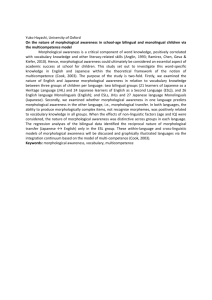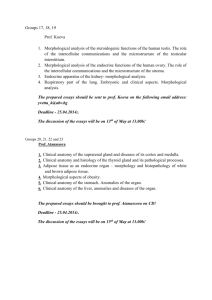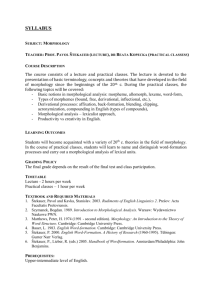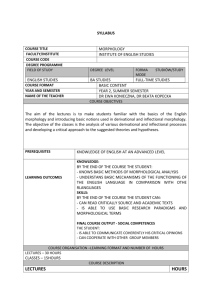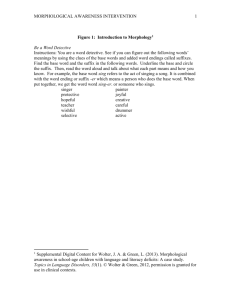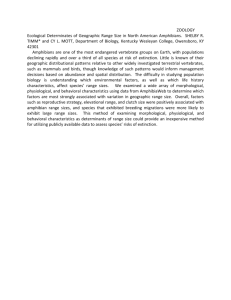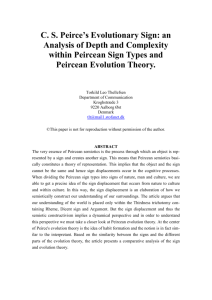WORD - Semiosis Evolution Energy
advertisement
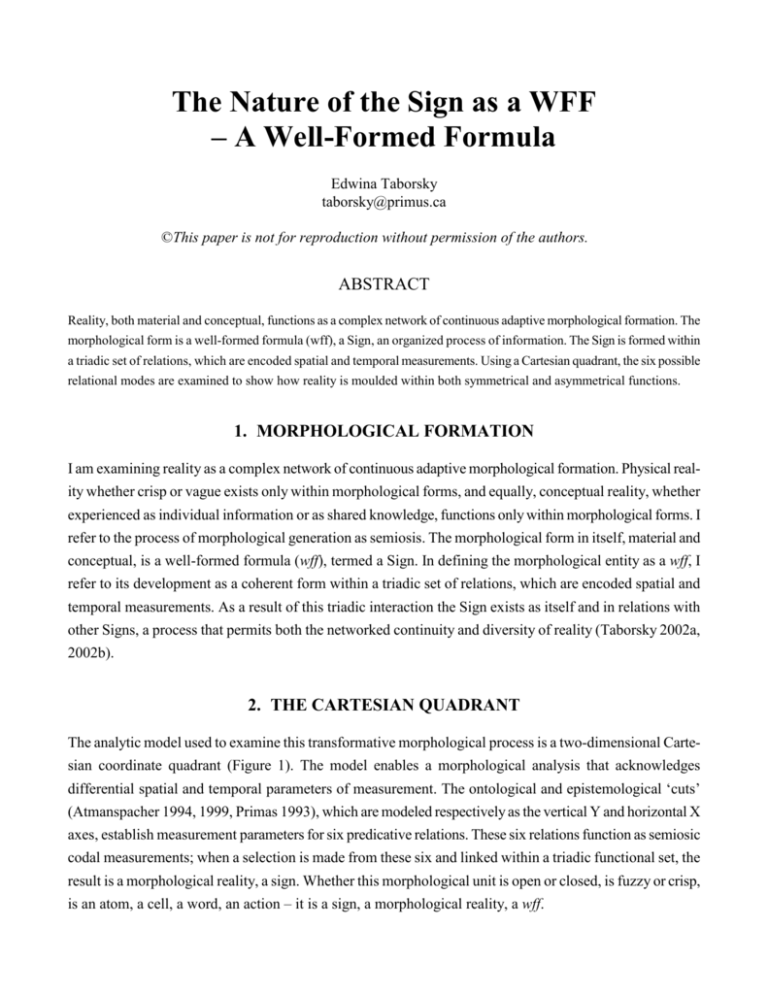
The Nature of the Sign as a WFF – A Well-Formed Formula Edwina Taborsky taborsky@primus.ca ©This paper is not for reproduction without permission of the authors. ABSTRACT Reality, both material and conceptual, functions as a complex network of continuous adaptive morphological formation. The morphological form is a well-formed formula (wff), a Sign, an organized process of information. The Sign is formed within a triadic set of relations, which are encoded spatial and temporal measurements. Using a Cartesian quadrant, the six possible relational modes are examined to show how reality is moulded within both symmetrical and asymmetrical functions. 1. MORPHOLOGICAL FORMATION I am examining reality as a complex network of continuous adaptive morphological formation. Physical reality whether crisp or vague exists only within morphological forms, and equally, conceptual reality, whether experienced as individual information or as shared knowledge, functions only within morphological forms. I refer to the process of morphological generation as semiosis. The morphological form in itself, material and conceptual, is a well-formed formula (wff), termed a Sign. In defining the morphological entity as a wff, I refer to its development as a coherent form within a triadic set of relations, which are encoded spatial and temporal measurements. As a result of this triadic interaction the Sign exists as itself and in relations with other Signs, a process that permits both the networked continuity and diversity of reality (Taborsky 2002a, 2002b). 2. THE CARTESIAN QUADRANT The analytic model used to examine this transformative morphological process is a two-dimensional Cartesian coordinate quadrant (Figure 1). The model enables a morphological analysis that acknowledges differential spatial and temporal parameters of measurement. The ontological and epistemological ‘cuts’ (Atmanspacher 1994, 1999, Primas 1993), which are modeled respectively as the vertical Y and horizontal X axes, establish measurement parameters for six predicative relations. These six relations function as semiosic codal measurements; when a selection is made from these six and linked within a triadic functional set, the result is a morphological reality, a sign. Whether this morphological unit is open or closed, is fuzzy or crisp, is an atom, a cell, a word, an action – it is a sign, a morphological reality, a wff. The vertical ontological Y cut, a result of temperature differentiation, demarcates spatial experience into internal and external spatial values. The morphologies within each zone are asymmetrical, internal space provides an insoluble completeness of data and external space provides a reducible discreteness of information. The horizontal epistemological X cut differentiates two further asymmetries; that between the local (individual) spatial values and the global (communal) spatial values. This is an important differentiation, for a basic property of a robust wff is its ability to permit the informational interaction between local nondistributed and communal distributed measurements. With this cut, which acts as the introduction of the temporal parameters of present, perfect and progressive time (Matsuno 1998, 1999), we now have an analytic scheme of four quadrants, I, II, III and IV (Figure 1). I add two further functions to the quadrant, namely, the aspatial and atemporal universal function, and the interface function located at the coordinate origin, which brings the relational functions to six in total (Table 1). 3. SEVEN MEASUREMENTS The morphological architecture comprises seven basic measurements: internal and external space; local and global space; and present, perfect and progressive time. Internal spatial measurements develop informational morphologies without a boundary; that is; the function is isolate and cannot ‘see’ or react to spatial parameters. This type of information is high energy, vague and therefore not niche-dependent, expansive and rapidly dissipative; and, when linked to other measurements, promotes ‘roll-over’ transformations of informational content. External spatial measurements designate the morphological boundary as definitive of the information content. Local spatial functions establish morphological forms that are contextual, non-distributed descriptions that function as discrete informational sets. Global spatial measurements set up general morphological forms with distributed nonlocal parameters of informational interaction that function as symmetry-inducing normative constraints. Time is not an abstract detached measurement (Newtonian/Galilean linear time) but is a concrete material measurement functioning as a compositional property of the morphological reality. There are three materially different temporal measurements which produce three different morphological realities (Matsuno 1998, 1999). Present time measures a reality that functions within ‘now’ time without links or references, without past or future. The information provided by the morphological measurement of pure present time operates only in internal and local, i.e., isolate space. An example is a ‘feeling of heat’ or the result of the first thermodynamic law of universal energy. Perfect time moulds experience within distinct asymmetrical parameters, i.e., as ‘this’ instantiation differentiated from ‘that’ instantiation; that is, as operating with specific properties and enables individual comparisons. It operates in external and local, i.e., closed space. Progressive time establishes values within a generalized continuity; it has no capacity to describe an individual state whether in present or perfect time but can only deal with commonalities operating as a continuous morphology. It operates within global or open space and both internally and externally. These seven measurements operate within the dynamics of asymmetry and symmetry. Local space and present and perfect time contribute to asymmetry, i.e., to differentiation of form and unique relations; global space and progressive time contribute to symmetry, i.e., to communal cohesion and continuity. These seven measurements function as relations. There are six relations, defined by Peircean code (see appendix) and differing according to spatial and temporal modes and functions (Table 1). Table 1: The Six Relations: defined by code/space/time/function 1-1 Firstness as Firstness 2-2 Secondness as Secondness 2-1 Secondness as Firstness 3-1 Thirdness as Firstness 3-2 Thirdness as Secondness Internal Local External Local Borderline Interface External Global Internal Global Present Time Perfect Time Perfect-Present Time Progressive-present Time Progressive-perfect Time Possible Information Discrete Actual Information Attractor Phase Statistical Average Future Propensity 3-3 Thirdness as Thirdness Aspatial Atemporal Imaginary Hypotheses 4. THE RELATIONS A relation is a dyadic string, a primitive morphology of interaction, where two nodes functioning as horizons of influence link up to provide a configuration of data, information or knowledge functioning within time and space. Within the Peircean semiosis of relations "these different modes of relation are different modes of connexion" (Peirce CP. 3:464). A relational string does not exist on its own. Following the principle of the superposition of states, any string exists by virtue of a superpositional bonding with two or more states. The wff or well-formed formula, the Sign, is the result of a transformation of the informational and energy content of three relations, set up in a triadic interaction of input/mediation/output (see Figure 2). These three terms can also be examined within the Peircean terminology as Object, Representamen and Interpretant. The robust sign, as a wff, is never a dyad, which would merely be an Interpretant signifying, metaphorically, an Object, i.e., a mechanical interaction. The dyad, it should also be noted, is a Saussurian frame, where the Signifier (input data) is related to the Signified (output meaning) via the mediation of an external operator, language. The sign as a wff operates as a dynamic triadic transformational process with the Interpretant relation presenting itself as a transformed measurement, acting as a representation of its Object relation. This interpretation requires a reference to a logical continuity of experience, the mediate relation, the Representamen. The triadic wff emerges as a morphological reality by a process that selects three of the six possible relations and moulds them into a coherent function. This choice will determine the nature of the information carried by that wff, and the nature of the possible interactions that information can have with other wff’s. 4.1 The most basic and primitive relation is found in quadrant II. This relation moulds information with- out boundaries, as an isolate state, in internal and local space and present time. The nature and horizons of influence of its informational content is therefore vague and undifferentiated. As such, the content in this morphological phase should more accurately be understood, not as information, a term that implies discrete differentiation, but as vague sensate input, enabling multiple and varied subsequent interpretations. It thus is a basic agent in promoting the emergence of new signs, by virtue of the relatively unformed nature of its informational content. An example would be a sensation of ‘hotness’ which can then be transformed into the specific information of either a malfunctioning furnace or a fever. It could be a provision of a chemical while the cell is still developing the meditative means to use this chemical; the provision might promote the development of normative tactics in the cell to use that chemical. This measurement acknowledges only that there is an input of unexamined and therefore unbound data located internally in local space and present time. This data can be transformed into discrete usable information by the semiosic act which must measure and stabilize its content by linking it to two other relations; otherwise, its data content will rapidly dissipate. It is an important relation, confirming the veracity of chance and the openness of outputs in this universe. The relation is coded, using Peircean terminology, as 1-1 or Firstness as Firstness (see appendix). Topologically, one can define its information content as ontologically real and epistemologically imaginary. 4.2 The second relation is found in quadrant I. This relation uses that input energy from Quadrant II and moulds individual forms functioning within the closures of external and local space and perfect time. The form in this quadrant has achieved differentiation, it is closed and establishes a factual or ‘reasonably’ crisp identity in local space and perfect time. Any discrete entity, from a rock to a word, can be considered an example of this ‘definitive definitiveness’ and it is the basis of most of our daily experiences; it is facticity, it is information. Modernism, nominalism and mechanism have all focused on the morphologies within this relation. The relation is 2-2, or Secondness as Secondness. Its information can be understood as both ontologically and epistemologically real. 4.3. The two quadrants produced by the horizontal epistemological cut, the X cut, introduce non-local or global space and temporal continuity; in particular, this cut permits open — as differentiated from isolate and closed— systems and a progressive and continuous time measurement. What we now have is a bileveled architecture, permitting both asymmetrical and symmetrical interactions, enabling both metabolic individual processes in quadrants I and II, and reproductive or causal processes in quadrants III and IV. The measurements in quadrants III and IV provide distributed values that ensure temporal continuity and the development of a future-oriented causality produced within the codes of communal habits, of general laws, of regularities of morphological forms. These values act as symmetry-inducing constraints to guide and inhibit the emergent local, individual instantiations developing in the local level (quadrants I and II) in perfect or present time. Our world cannot function within only the top level quadrants of undifferentiated isolate energy and discrete closed instances, for this would reduce reality to randomness. There must be a function that enables symmetry and reproductive continuity. The X-cut provides these functions by adding two relations and ensures an open, symmetry-restoring and therefore complex system. 4.3.1. Quadrant III functions in internal and global space and progressive time. It operates as a ‘virtual memory processor’. As a global relation, its measurements are distributed in space; it ‘cancels’ spatial distances; as internal, these measurements and the information they carry are inclusive rather than exclusionary; as progressive, the relation links past to future morphologies and provides not only continuity but also evolutionary and adaptively innovative capacities. If we use an example of this relation, the internet search engine, we find that “search engines entertain a model of the Internet that evolves with the Internet” and “continuously reconstruct the past by updating their indices” (Wouters, Helsten and Leydesdorff 2004, emphasis added). Mathematically, we can refer to the virtual mode as a complex negotiator of information, in that it includes both real propensities or real numbers, which we can understand as actual memories, and imaginary propensities or imaginary numbers, which we can understand as vectoral propensities with other morphologies both unformed and formed. This relation is a major influence in the development of complex morphologies, for it uses imaginary measurements both ontologically and epistemologically. It acts as an open non-linear non-historical catalogue of solution concepts, and can be understood as a networked evolving ‘search engine’ of any and all links within the past and current, direct and indirect, experience of the community. These links might not develop into stable common rules of morphological formation (i.e., functioning in quadrant IV); however, their virtual existentiality remains extant, in both weak and strong form, and they are available for potential selection by an emerging instantiation. Additionally, this relation is functionally ‘in tune’ with the realities of the current environment for “the past in the Internet is constantly overwritten by the search engines” [and] “the present, from where the data is collected, affects search results considerably” (Wouters, Helsten and Leydesdorff 2004). This measurement enables a system to reason about input signals based on information that is both currently received and information that was received in the past or is accessible via other networked links. The time required for this ‘reasoning’ can be examined within Benjamin Libet’s ‘temporal factor’ in cognition of 0.50 second (2004). This ergodic inclusiveness of unformed and non-habitualized propensities permits an emergent instantiation to bring with itself multiple alternative models of itself as a measurement proposal to the development of a new instantiation. This relation is essential in providing hypothetical morphologies that can introduce robust adaptive values and is an overlooked and vital mode of measurement. The relation is 3-2 or Thirdness as Secondness. It is both ontologically and epistemologically imaginary. 4.3.2. Quadrant IV functions in external and global space and progressive time. It is, like 3-2, a communal measurement but, functioning in external or actualized space, it lacks the epistemological imaginary propensities of the internal mode. It functions as a bell curve statistical average, basing its measurement value on a symmetry-inducing model of the statistical average of the already-actualized individual morphological forms and acts to constrain the nature of emerging forms by the pressures of its majority identity. Internal Realm External Realm II I Local Space Perfect Time 2-2 Discrete Instance Local Space Present Time 1-1 Available Energy Epistemological Cut 2-1 Interface Global Space III Progressive Time 3-2 Networked collection of any and all potentialities for emerging instances to use as models IV Global Space Progressive Time 3-1 Statistical Average Model only of Actualized Instances Ontological Cut Figure 1 - The Cartesian Quadrant As Kauffman said, “in sufficiently complex systems, selection cannot avoid the order exhibited by most members of the ensemble” (1993:16). This referential model functions as a kind of ‘attractor-glue’ (Paton and Matsuno 1998) to which the emerging nascent instantiations are attracted, and which they then take as their guide for development. The relation is 3-1 or Thirdness as Firstness. It is epistemologically real and ontologically imaginary, and produces an abstract model of the record of instantiated actualities. 5. There are two relations ‘outside’ of this quadrant. 5.1. The full imagination can be understood as the universal rationality of pure mind, affirming that the universe, while not designed or in any way a priori does organize energy within evolving complex and logical networks. This relation is aspatial and atemporal. The relation is 3-3 or Thirdness as Thirdness and is, I maintain, a property of all informational and morphological realms, the physico-chemical, the biological and the socioconceptual. 5.2 The other relation is the Interface, a borderline relation, which functions as an initial condition (origin) at the point of intersection of the Y and X cuts of differentiation. It acts as an intervening random-phase pointer to promote the coupling of relations; if it does not accomplish these links its information and energy content will dissipate. Within Peircean terms, it can be understood as an act of ‘prescission’, which “is always accomplished by imagining ourselves in situations in which certain elements of fact cannot be ascertained" (CP 2:428). It is a highly charged anticipatory relation that focuses “attention to one element and neglect of the other” (CP 1.549). Its two different modes of codification are continuously entwined in their attempt to link relations; therefore, external actuality is always exploring the new informational potentialities within internal vagueness and vice versa, and symmetry is always exploring asymmetry and vice versa. The relation is 2-1 or Secondness as Firstness, operating in local space – both isolate and closed - and both present and perfect time. There are six interface typologies characterized by the dyadic bond of the interface relation with another relation. We will not go into any depth at this time in examining these typologies and will only point out the crucial importance of this relation. The Interface can function alone (see 5.2.1) or will be linked with any of the other five relations. The Interface, acting as this coupling function is a ‘pointer function’, and enables a complex superposition of these six relations. 5.2.1 The chaotic or strange attractor is the relation of 2-1 alone. It operates without links in which case the measurement acts as an initial condition of differentiation in a state of high excitation. It is highly volatile and expansive (its internal spatial and present temporal nature) and ‘confrontational’ (its disconnected external spatial and perfect temporal nature). If it does not find/attract symmetry inducing measurements its informational content will dissipate. It can be understood as a relation of anticipatory exploratory freedom and is more frequent in complex systems. 6. MORPHOLOGICAL FORMATION We now examine the semiosic process of morphological formation. The morphological architecture of a wff/sign is triadic in the shape of a non-linear windmill - not a linear triangle as often envisaged. Input Output Mediation Figure 2 – The Semiosic Sign It is made up of three relations, whose integration enables morphological realities to exist and interact [Figure 2]. The three relations can be defined as Input Relation, Mediation Relation, and Output Relation. Peircean terminology is Object-Relation, Representamen-Relation and Interpretant-Relation. The Input relation can also be understood as a signal, as data, as a minor premiss. The Mediation relation can be understood as knowledge, memory, universal or major premiss. The Output can be understood as information, conclusion, interpretation. 6.1 Dependent on the measurements of the relations involved, the sign can function in different geomet- ric forms, as a point, as a linear line, as a nonlinear parabola. The most robust morphology is a parabola, for here, the apex or mediate relation functions as the compressed measurement of the symmetry-inducing global space/progressive time measurements, with the other two lines understood as the asymmetrical differential values of local input and output. What we find is a superposition of states, where some measurements will dominate and others will become peripheral or will operationally dissipate. What drives the different results? The triadic morphology is not a self-organized autocatalytic or autopoietic reality (Maturana & Varela 1980) but is a result of complex networked interactions with other morphological measurements, both internal and external, both local and global. That is, the sign as a wff is not isolate but open; its so-called ‘selforganization’ is not that of an isolate self-defined assertion but a networked collaboration. 6.1.1 As an example, we posit a triad of three relations: 1-1, 2-1 and 2-2. These three relations are both in- ternal and external but they are all local; there is no symmetry-induction or global measurement of Thirdness. Link them and a resultant form can be either: 1-1-1, a short-term internal feeling; or 1-1-2, a brief consciousness of that feeling; or 1-2-2, a spontaneous cry as a reaction to that internal feeling. In the first case, energy within the discrete morphology of 2-1 and 2-2 must be dissipated to reduce the final form to that vague internal feeling. In the second and third cases, energy must be dissipated but it will not be as much as in the first example. In all cases, no memory is involved. What causes the emergence of a particular morphology? The particular morphology functions within a larger morphological domain, that of its current environmental network and its historical network and therefore, is linked, informationally, with this larger domain. 6.1.2 Another example could be: 2-2, 2-1, 3-2. These relations are both internal and external, but more ex- ternal than internal, in local and global space. Link them and you could get, dependent on the nature of the morphological or semiosic act within the larger morphological domain: 2-2-3, which is a normative mechanical act, such as a heart beating according to its internal typological symmetry-inducing memory encoded within Thirdness. Or the morphological form might be encoded as 2-2-2, where it loses the forward-focused aim-direction of symmetry and provides a strictly mechanical entity, without an internalized set of rules, such as a weathervane which can only react to an external causality. Or, you could get 1-2-3, which is the robust ‘normative’ sign, acting within relations that provide both phenotype (local) and genotype (global) results, as well as within relations that provide both freedom (local internal) and individual boundaries (local external). 7. CONCLUSION The production of morphological signs, understood as measurable variables of information functioning in modes of space and time, operates within a complex semiosic architecture (Figure 1). This architecture sets up the sign as a wff, a mediated and coordinated triad of relations (Figure 2). The relations are chosen from a set of six possible relations, defined by different spatial, temporal and functional properties (Table 1). The triadic morphology operates within three of these six. These three relations may differ from each other or the triad may use three similar relations; e.g., three relations in the mode of Firstness as Firstness (1-1) will produce an expansive explosion of unfocused data. This architecture enables a complex and dynamic information generation in all realms of reality. First, the system permits a continuous flexibility of morphological formation, for the open and vague nature of the internal data functioning in the relation within the second quadrant (1-1) means that the use of its informational input supplies an important element of freedom of interpretation. The Interface relation (2-1) with its capacity to pick up this input information, define it as origin (i.e., without the constraints of memory) and link it to any of the other relations, provides the system with a tremendous evolutionary adaptability and a capacity to promote diversity of individual instantiations. A morphological instance can emerge that is strictly local and without memory; this random information can be picked up by another measurement with global properties and incorporated into its memory base to guide future instantiations. Other forms are possible; a morphological reality can emerge that is both local and global; i.e., it has the capacity for both irreversible metabolism and a reproduction of type. A morphological reality can emerge which computes its next instantiation referenced only to the attributes of its present state (mimetic iconicity); this would provide for an expansionist spatial breadth of this form. A morphological reality can emerge which computes its next instantiation referenced to an historical connection (indexicality); this would provide for increased depth and longevity of this new specific type. Importantly, a morphological semiosis using the six relations has the capacity for, not one, but three types of memory and symmetric continuity. There is the historical memory of accumulated values of the successfully articulated collective (3-1, the statistical average); an example is natural selection. There is the memory of virtual propensity (3-2), which permits tacit links which may never be articulated but which remain available for future morphological attempts at formation. Finally, there is the memory of rationality (33), which lies, I maintain, at the basis of life, understood as the increasingly complex yet pragmatic logical ordering of energy/matter. This morphological architecture, made up of six relations integrating different modes of space and time and a triadic morphological process integrating symmetry and asymmetry, provides our universe with a system that permits specificity and uniqueness, while enabling the instantiation to promote the robust capacities of a continuity of type. These properties enable typological control over the environment, as well as providing the freedom to develop new knowledge and new interactions with the environment. REFERENCES Atmanspacher, H. 1994. “Objectification as an Endo-Exo Transition”, Atmanspacher, H. and G. Dalenoort (Eds.). Inside Versus Outside, Berlin: Springer-Verlag, 15-32. Atmanspacher, H. 1999. “Cartesian Cut, Heisenberg Cut, and the Concept of Complexity”, The Quest for a Unified Theory of Information, W. Hofkirchner (Ed.). Amsterdam: Gordon /Breach, 125-147. Kauffman, S. 1993. The Origins of Order, New York, Oxford University Press. Libet, B. 2004. Mind Time: the temporal factor in consciousness. Harvard University Press. Matsuno, K. 1998. “Dynamics of time and information in dynamic time”, BioSystems 46, 57-71. Matsuno, K. 1999. “The clock and its triadic relationship”, Semiotica. 127, 1/4, 433-452. Maturana, H. and F. Varela. 1980. Autopoiesis and Cognition. Dordrecht: D. Reidel. Paton, R. and K. Matsuno. 1998. “Verbs, glue and categories in the cellular economy”, Holcombe, M. Paton, R. (Eds.) Information Processing in Cells and Tissues. New York: Plenum Press, 253-260. Peirce, C.S. 1931-35. Collected Papers. Eds. Hartshorne, C. Weiss, P. and A. Burks. Cambridge, MA.: Harvard University Press. Citations are by volume and paragraph number. Primas, H. 1993. “The Cartesian Cut, the Heisenberg cut, and disentangled observers”, Symposia on the Foundation of Modern Physics: W. Pauli as a Philosopher. K. Laurikainen and C. Montonen (Eds.), Singapore: World Scientific, 245-269. Taborsky, E. 2002a. “Semiosis and Energy Transformation”. D. Dubois (Ed.) Computing Anticipatory Systems. CASYS 2001. American Institute of Physics, AIP Conference Proceedings 527, pp. 128138. Taborsky, E. 2002b. “Energy and Evolutionary Semiosis”, Sign Systems Studies 30(1),361-381. Tartu University Press. Wouters, Paul, Iina Helsen and Loet Leydesdorff, .2004. “Internet time and the reliability of search engines”, First Monday. Vol. 9, No. 10, October. Appendix The three Peircean modal categories refer to the quality of information provided by the system. Firstness, symbolized as “1’, is defined as a mode of potentiality. It is an internal and local mode. Information in this mode is potential but not actual. Secondness (2) is defined as a mode of individual actuality. Information in this mode exists ‘as it is’. It is an external and local mode. Thirdness (3) is defined as a mode of generality, of necessity, of rules and laws. Information in this mode exists as knowledge, understood as a substratum of normative conventions. It is a non-local mode and functions within both the internal and external zones.



